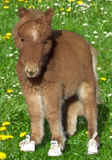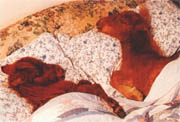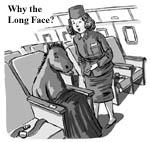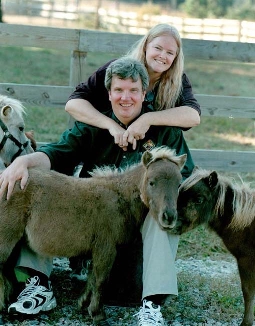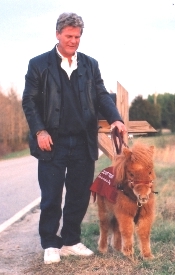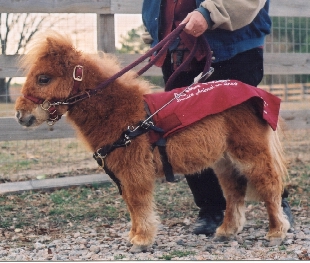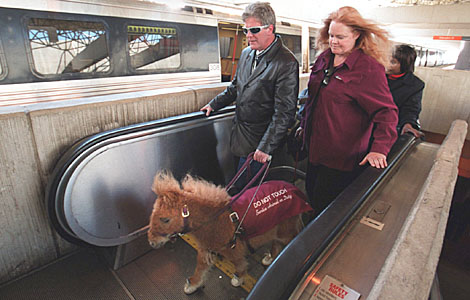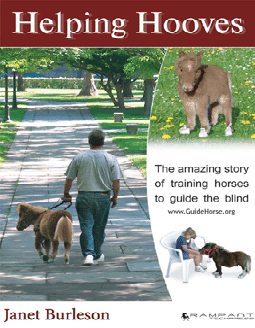Shari Bernstiel always wanted a horse. Even when she began
losing her sight in elementary school, she begged her mother for
a pony every year for her birthday.
"She'd say, 'Where would we keep it?' " said Bernstiel - a
good question, considering that the family lived in a townhouse
in North Wales. "I'd say, 'I'll keep it in my bedroom.' "
In December, Bernstiel, who is legally blind, got her wish,
though it's not exactly the horse of her dreams. Tonto is a
27-inch miniature horse Bernstiel uses as a guide animal, one of
the first of its kind in the nation.
And while Tonto doesn't live in her bedroom, he does spend a
good deal of time in the house. "Do you see hoofprints on the
carpet?" Bernstiel asked, as the 115-pound potbellied pony
wandered around the basement of her family's busy house in
Lansdale.
The mini-horse, bred from a Shetland pony and slightly taller
than a German shepherd, is part of an experimental program of
the Guide Horse Foundation in Kittrell, N.C.
"It's one of the coolest new uses for animals for helping
people," said Sue McDonnell, an equine behavior specialist at
the University of Pennsylvania School of Veterinary Medicine.
McDonnell, who also has a miniature horse - there are 150,000
registered in the United States - said the animals are easy to
train and enjoy living with people.
A few years ago Bernstiel's mother told her to watch a
segment on the TV show 20/20 about the first guide horse,
Cuddles.
"I was shocked, but if you think about it, look at Roy Rogers
and Trigger, look at what he trained that horse to do," said
Bernstiel, whose house has so many horse knickknacks and stuffed
animals it's easy to trip over them if you're not careful.
A love of horses and ever-dwindling sight have defined
Bernstiel's life since childhood, when she was diagnosed with
Stargardt's disease, a degenerative condition. With her sight
getting worse in recent years, "I figured with the passion I had
for horses this seemed like a thing to try."
Why not a dog? Blame it on Rio, her neurotic German shepherd.
"I thought he'd get jealous," she said.
The big advantage of horses is their 35-to-40-year life
expectancy, three times that of dogs. The downside is the
upkeep: They require a (miniature) barn, hay and grain, regular
hoof clippings, and a companion horse. And forget about the lawn
- Bernstiel's has been nibbled to mud.
Janet Burleson, who started the Guide Horse Foundation, is a
longtime horse trainer who got the idea from watching her own
miniature, Twinkie, navigate her way through a flea market,
carefully avoiding electrical cords and picking the smoothest
paths.
"She was working like a guide naturally," Burleson said.
She and her husband, Don, placed their first horse with a man
in Maine in 2001. Bernstiel and a woman in Texas got the next
two. The foundation gives the horses away, relying on donations
for the $25,000 cost of training an animal for six months to a
year.
Bernstiel, chosen out of 80 applicants, worked with Tonto for
three weeks before bringing him home on Dec. 13 to join a packed
household consisting of her husband, Jim, four teenage boys
(including identical triplets), a dog and three cats.
Like a guide dog, Tonto doesn't move on his own. He responds
to 23 commands, such as right and left, or load
up and unload to get in and out of a van. "I can't
just say, 'Tonto, I want to go to Clemens,' " Bernstiel said.
On a walk around her neighborhood, he deftly negotiated
traffic, muddy sidewalks, and a construction vehicle blocking
their path. With a little nudging, he trotted across the street,
his hooves clicking on the pavement.
The duo are an endless source of fascination. A car with an
elderly couple inside slowed down to gawk. Whenever Bernstiel
goes to a store, she draws a crowd. What irks her are the
people, mostly adults, who try to pet her horse even though he
wears a sign saying that he's working.
Caring for Tonto requires more than a brushing and some
kibble. Tonto and her buddy, Kayla, live in a small barn in the
backyard that her husband and sons built. Bernstiel has to groom
and feed them, muck out the stall, and learn basic horse
psychology.
As for potty problems, well, there haven't been any so far.
Tonto is house-trained, and paws the ground when he has to go
outside. When he's inside he wears four modified baby sneakers
so he doesn't slip on floors.
Bernstiel hasn't been to any public place where Tonto was not
allowed, though one store manager waved an arm in front of her
face to see if she was really blind.
"I don't have to answer questions [about Tonto] but I will,
because I know people have never heard of this. But I always
know my rights," she said, meaning she's legally allowed to take
Tonto on planes, trains and buses, and into movie theaters and
restaurants. For now, they mostly walk to nearby stores.
While Bernstiel is smitten with her horse, some people think
the idea is strange.
"We don't know that there's a good reason [to have a guide
horse]. Dogs have worked successfully for almost a century,"
said Joanne Ritter, a spokeswoman for Guide Dogs for the Blind
in San Rafael, Calif.
Ritter sees drawbacks, such as problems gaining access to
places run by people who don't know what to make of a guide
horse, and more attention on the blind person. As for a dog's
shorter life span, she said, people's needs change over the
years, so getting a new animal every so often could be a good
thing.
Anyone who's ridden a horse can imagine the biggest potential
drawback: As prey animals, horses are easily spooked. But like
horses used in battle or to police city streets, the miniatures
are trained to "spook in place," said Burleson.
Bernstiel's animal-loving family pitches in to care for
Tonto. Her dog, however, has issues. "He's such an insecure nut,
he's pathetic," she said, making sure to pet the dog while
scratching Tonto's chest.
Bernstiel and her horse have a special bond, but that doesn't
mean she's given up her dream of having a normal-sized horse.
"People say you've gotten your horse," she said. "I say, it's
not the same thing. It's not like I'm going riding off into the
sunset on Tonto."
